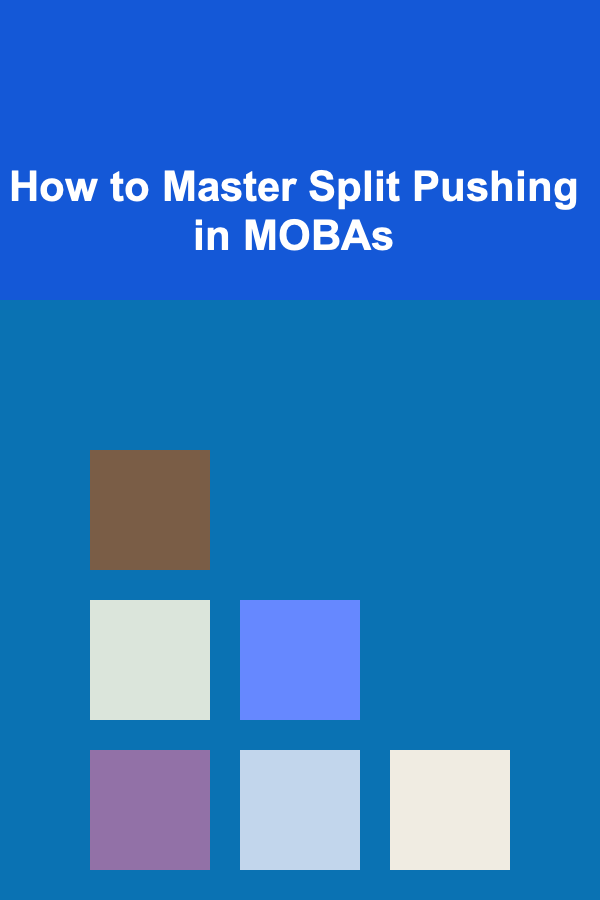
How to Master Split Pushing in MOBAs
ebook include PDF & Audio bundle (Micro Guide)
$12.99$8.99
Limited Time Offer! Order within the next:

Split pushing is one of the most powerful and strategic maneuvers in multiplayer online battle arena (MOBA) games. This tactic can apply pressure on the map, create opportunities for your team, and force the enemy to make decisions that favor your side. While often misunderstood or underutilized, mastering split pushing can elevate your gameplay and provide your team with significant advantages. In this article, we'll break down everything you need to know about split pushing, from its fundamentals to advanced strategies and tips that will help you take control of the map.
What is Split Pushing?
Split pushing involves a single player pushing a lane away from the main group, with the intent of applying pressure on the enemy team. The goal is not just to push the wave and take down towers but to force the enemy to divert attention, leaving your team with the upper hand in other parts of the map. This tactic is most commonly used in MOBA games such as League of Legends , Dota 2 , and Smite, where pushing lanes and map control are crucial to victory.
Core Objectives of Split Pushing:
- Apply pressure on multiple lanes: By pushing a lane, you draw attention away from other areas, possibly leading to opportunities for your team to capitalize on.
- Force enemy rotations: When an enemy team sees that you are pushing a lane, they often have to send multiple players to defend. This opens up opportunities for your team to either push other lanes, take objectives, or initiate fights on favorable terms.
- Create map control: Split pushing can help establish vision in key areas or force the enemy to use resources and time inefficiently, providing your team with more freedom.
Mastering split pushing requires an understanding of timing, lane management, and positioning. It's a tool that can be a game-changer when executed properly, but when misused, it can also backfire.
Key Concepts in Split Pushing
Before diving into the strategies, it's important to grasp a few core concepts that govern split pushing. These principles apply across various MOBA titles, though each game may have its nuances.
1. Wave Management
A fundamental aspect of split pushing is how you manage the minion waves. Properly pushing and controlling minions ensures that you maintain lane pressure while also mitigating the risks of being caught by the enemy.
- Wave Clear: The ability to quickly clear minion waves is essential for effective split pushing. Champions or heroes with high wave-clear abilities can push lanes more efficiently and return to safety before the enemy can retaliate.
- Freezing the Wave: Freezing involves positioning your minion wave near your turret, preventing it from pushing forward. This strategy allows you to maintain control of the lane without overextending. It's useful when you want to maintain pressure in a lane but don't have immediate plans to push further.
- Slow Pushing: A slow push involves creating a wave that builds up and crashes into the enemy's tower with more force. This tactic often works best when combined with other forms of split pushing, as the wave will eventually reach the enemy's tower, forcing them to commit resources to defend it.
2. Positioning and Map Awareness
Positioning is critical when you're split pushing. You need to strike a balance between applying pressure and ensuring that you don't overextend and get caught out by the enemy.
- Safe Pushing: Position yourself in areas where you can quickly escape if enemies show up. Pushing too aggressively or too deep into enemy territory increases your risk of being ambushed.
- Map Awareness: Always be aware of where the enemy team is. If you're pushing a lane and several enemies are missing from the map, it's a sign that they may be coming to ambush you. Use wards, vision, and awareness of enemy cooldowns to avoid being caught.
- Split Pushing with Vision: Never split push without vision. Place wards or use trinkets to keep an eye on enemy movements, especially near key objectives such as Dragon, Baron, or Roshan.
3. Champion/Hero Selection
The right champion or hero is key to effective split pushing. Not every character is designed for this role, so understanding which champions excel in split pushing will make a huge difference in your ability to apply pressure.
- Pushers : These champions have abilities that allow them to clear waves quickly, such as Jinx , Tristana , Fiora , Split Push Irelia , or Lone Druid. Their goal is to apply sustained pressure on a lane.
- Tanky/High Mobility Heroes : Sometimes, you need a tank or high-mobility character that can push without risking being caught. For example, Shen or Malphite might not deal a ton of damage but can push while staying safe.
- Teleport or Global Presence : Some heroes have teleport abilities that allow them to quickly join the main fight or escape if they're in danger. Heroes like Twisted Fate , Shen , and Kennen can be highly effective in split-pushing because they have global or semi-global abilities.
Advanced Strategies for Split Pushing
While the basics of split pushing can be learned quickly, mastering it requires fine-tuning your strategies. Here are some advanced techniques that separate good split pushers from great ones:
1. Creating the Threat of 1v1
When you're split pushing, you're often in the 1v1 scenario against an enemy champion. To win this encounter, it's crucial to ensure that you either have the upper hand in terms of champion matchups or that you have the tools to escape if things go wrong.
- Watch for Teleports: If the enemy has a teleport or mobility tool, they might try to catch you off guard. Pay attention to their positioning and save your own mobility abilities or items to disengage or fight back.
- Solo Duels : Some champions are great at dueling, so when split pushing, use the opportunity to engage 1v1. For example, champions like Jax , Riven , and Tryndamere can push safely while also having the ability to outduel most champions.
- Psychological Pressure: Sometimes, the threat of 1v1 can force the enemy to overreact. A well-timed bait or an unexpected 1v1 challenge can throw the enemy off balance, causing them to make mistakes or miscalculate their rotations.
2. Timing Your Push with Objectives
Timing your split pushing with the spawning of major objectives is crucial. Split pushing works best when it creates pressure during key moments in the game. For instance, while your enemy team is preoccupied with an objective like Baron or Dragon, you can push a lane with minimal risk.
- Pushing During Enemy Focus: If the enemy team is focused on a major objective, your pressure in a side lane can force them to make difficult decisions. Do they continue fighting over the objective, or do they rotate to stop you from taking their towers?
- Using Objectives as Bait: Another tactic is to push hard during the respawn of large objectives. As you create pressure, your team can use the distraction to secure a key objective or win a team fight.
3. Split Pushing with Team Coordination
While split pushing may seem like a solo endeavor, it's actually highly effective when coordinated with your team. Effective communication and timing can ensure that you're not isolated or overextended.
- Drawing the Enemy's Attention: By pushing a side lane, you create an opportunity for your team to execute other plays, such as taking an objective or ambushing the enemy while they're distracted by you.
- Pushing Together with Your Team: In some scenarios, split pushing is most effective when done in conjunction with your team pushing another lane. This creates a "two-front" pressure that forces the enemy to defend multiple points at once.
- Flanking: In some situations, you can use split pushing as a way to flank the enemy. If the enemy is pushing mid-lane or fighting for objectives, split pushing can let you sneak behind them and hit them from unexpected angles.
Pitfalls of Split Pushing
While split pushing is a powerful tool, it's important to avoid the common mistakes that can easily lead to failure:
- Overextension: One of the most frequent errors in split pushing is pushing too far without proper vision or support. This makes it easy for enemies to take advantage of your isolation and take you down.
- Ignoring the Team Fight: Split pushing should not completely ignore your team's efforts in a fight. Constantly pushing without assisting your team when needed can leave them outnumbered in a crucial fight.
- Unaware of Enemy Teleports: If the enemy team has a champion with teleport or strong global presence, you need to be extra cautious. Always check the minimap for teleport timers and prepare to disengage if necessary.
Conclusion
Mastering split pushing is about more than just pushing lanes and hoping for success---it's about creating strategic pressure, making the right decisions at the right time, and executing with precision. With the right champion, an understanding of map dynamics, and coordination with your team, split pushing can become a core tool in your arsenal, allowing you to dominate the battlefield and outsmart your enemies.
Whether you're a solo queue player trying to climb or part of a coordinated team, split pushing offers endless opportunities to create advantages, outplay your opponents, and take control of the game. By combining solid wave management, proper positioning, awareness of objectives, and teamwork, you'll be well on your way to mastering this crucial MOBA tactic.

How to Plan for Health-Related Expenses and Save for Them
Read More
How to Stage Your Home for a Virtual Tour or Online Listing
Read More
How to Use Labels for a Tidy Kitchen Drawer System
Read More
How To Master Acrobatic Rock Climbing
Read More
How to Plan a Bullet Journal for Art & Craft Projects
Read More
10 Tips for Designing Unique Puppet Characters
Read MoreOther Products

How to Plan for Health-Related Expenses and Save for Them
Read More
How to Stage Your Home for a Virtual Tour or Online Listing
Read More
How to Use Labels for a Tidy Kitchen Drawer System
Read More
How To Master Acrobatic Rock Climbing
Read More
How to Plan a Bullet Journal for Art & Craft Projects
Read More